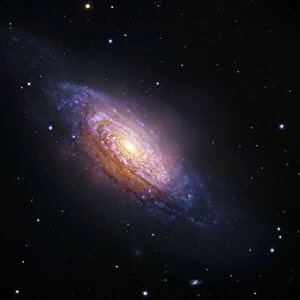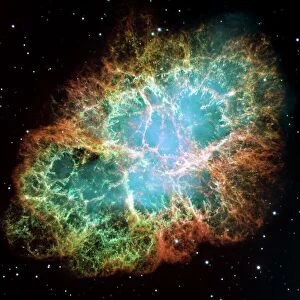Home > Science > Space Exploration > Nebulas
Crab nebula gas filaments
![]()

Wall Art and Photo Gifts from Science Photo Library
Crab nebula gas filaments
Crab Nebula. Hubble Space Telescope image of the interior of the Crab Nebula supernova remnant (M1). Different elements are colour-coded: sulphur (pink), nitrogen (red), hydrogen (orange) and oxygen (green). These gases were expelled as a 10 solar mass star exploded as a supernova, an event witnessed by Chinese astronomers in 1054 AD. The core of the star survived as a pulsar, a rapidly- spinning neutron star (lower of the two bright stars just above and left of centre). The rotation of this star heats the surrounding gas, causing the blue glow seen here. Image from the Wide Field and Planetary Camera 2 on the HST
Science Photo Library features Science and Medical images including photos and illustrations
Media ID 6442955
© NASA/ESA/STSCI/HUBBLE HERITAGE TEAM/ SCIENCE PHOTO LIBRARY
Astrophysics Cosmology Crab Nebula Debris Explosion Hst Imagery Hubble Space Telescope Hydrogen Neutron Star Nitrogen Oxygen Star Death Stellar Sulphur Supernova Remnant
FEATURES IN THESE COLLECTIONS
> Science
> Space Exploration
> Hubble Telescope
> Science
> Space Exploration
> Nebulas
EDITORS COMMENTS
This print showcases the mesmerizing beauty of the Crab Nebula, a supernova remnant located approximately 6,500 light-years away from Earth. The image, captured by the Hubble Space Telescope's Wide Field and Planetary Camera 2, reveals intricate gas filaments that stretch across the nebula in vibrant colors. Each color represents a different element: pink for sulphur, red for nitrogen, orange for hydrogen, and green for oxygen. These gases were expelled when a massive star with a mass ten times that of our Sun exploded as a supernova over one thousand years ago. Chinese astronomers witnessed this extraordinary event in 1054 AD. Remarkably, at the heart of this celestial spectacle lies an enigmatic pulsar—a rapidly spinning neutron star—visible as one of two bright stars just above and left of center. The intense rotation of this surviving core heats up the surrounding gas to create the ethereal blue glow we see in this image. The photograph not only captures the remnants of stellar death but also offers us insights into cosmology and astrophysics. It serves as a testament to humanity's relentless pursuit to understand our place within the vastness of space while reminding us of nature's awe-inspiring ability to transform destruction into breathtaking beauty.
MADE IN THE UK
Safe Shipping with 30 Day Money Back Guarantee
FREE PERSONALISATION*
We are proud to offer a range of customisation features including Personalised Captions, Color Filters and Picture Zoom Tools
SECURE PAYMENTS
We happily accept a wide range of payment options so you can pay for the things you need in the way that is most convenient for you
* Options may vary by product and licensing agreement. Zoomed Pictures can be adjusted in the Basket.








